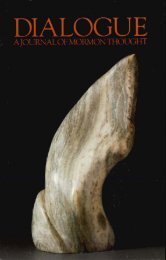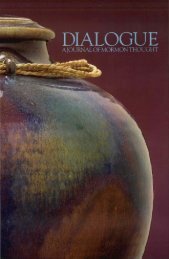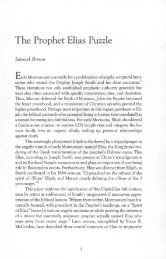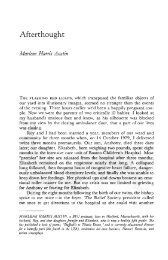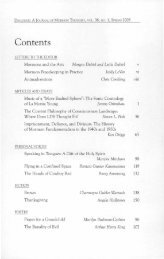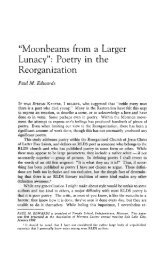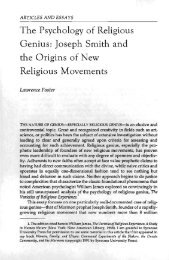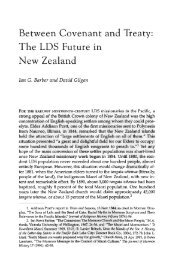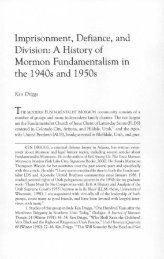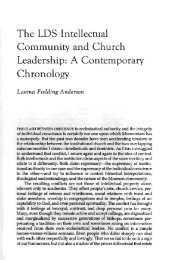Dialogue, Volume 25, Number 2 - Dialogue – A Journal of Mormon ...
Dialogue, Volume 25, Number 2 - Dialogue – A Journal of Mormon ...
Dialogue, Volume 25, Number 2 - Dialogue – A Journal of Mormon ...
Create successful ePaper yourself
Turn your PDF publications into a flip-book with our unique Google optimized e-Paper software.
Harrell: Form and Integrity 1<strong>25</strong><br />
The United States is a good breeding ground for kitsch art. Our<br />
democratic politics and our laissez-faire economics exalt the commonplace<br />
and the pr<strong>of</strong>itable. Nineteenth-century American immigrants were<br />
<strong>of</strong>ten poor, uneducated people looking for a better life. Blending in the<br />
"melting pot," these individuals produced a culture rich in individuality<br />
but poor in traditional artistic standards.<br />
If the United States <strong>of</strong> the nineteenth century was the "dumping<br />
ground <strong>of</strong> Europe," as one <strong>of</strong> my political science teachers termed it,<br />
what was the LDS Church? The early Church was the outcast <strong>of</strong> the<br />
United States! The Prophet Joseph was murdered, and the Saints were<br />
sent into exile in the desert. Artisans were sprinkled among the early<br />
Saints, and some fine architecture and crafts were produced under<br />
Brigham Young, but the principle business <strong>of</strong> the Saints was simply<br />
survival in a harsh and unfamiliar land.<br />
Although the early Church's attitude toward America could be typified<br />
as "Zion against Babylon," political and economic concerns led<br />
the Church in the early twentieth century to <strong>of</strong>ficially and un<strong>of</strong>ficially<br />
seek the approval <strong>of</strong> the American people. This meant capitalism, not<br />
cooperatives, and a host <strong>of</strong> American values. By the 1960s and 1970s,<br />
<strong>Mormon</strong>ism and Americanism had converged.<br />
As a result, many members <strong>of</strong> the Church have placed little value<br />
on a responsible attitude toward art. They don't realize that art is<br />
more than just entertainment. Latter-day Saints could use art to help<br />
them live the gospel. In accordance with our reverence for the earth,<br />
we could learn to value the materials <strong>of</strong> the environment. By crafting<br />
and buying things that will be long-lasting, functional, and beautiful,<br />
we could promote quality craftmanship in our communities, develop<br />
our aesthetic senses, and have more joy in the atmosphere <strong>of</strong> our homes.<br />
As we each consider the struggles <strong>of</strong> living the standards <strong>of</strong> the gospel<br />
in a telestial world, we could tell the truth about the joys and sorrows<br />
<strong>of</strong> discipleship. After all, what house built on half-truths has ever stood?<br />
Actualizing a culture like this would make us a peculiar people indeed.<br />
The spirit that troubled me after my conversations with Ken is<br />
gone now. It has only been a few months, but I can hardly remember<br />
the pain I felt. My thinking has not changed. I still believe that we<br />
deny reality, that we try to drown evil with a flood <strong>of</strong> sentimentality;<br />
but I don't feel bad about thinking that way now. Maybe it's because<br />
I've given up my naive, false beliefs about the total accuracy <strong>of</strong> the<br />
LDS world view. Or maybe I've only accepted the standards <strong>of</strong> the<br />
world.<br />
I do know that the questions I've asked are at the heart <strong>of</strong> <strong>Mormon</strong>ism.<br />
God has intentionally placed us here on an earth where we<br />
can come in contact with good and evil. We have the chance to taste




